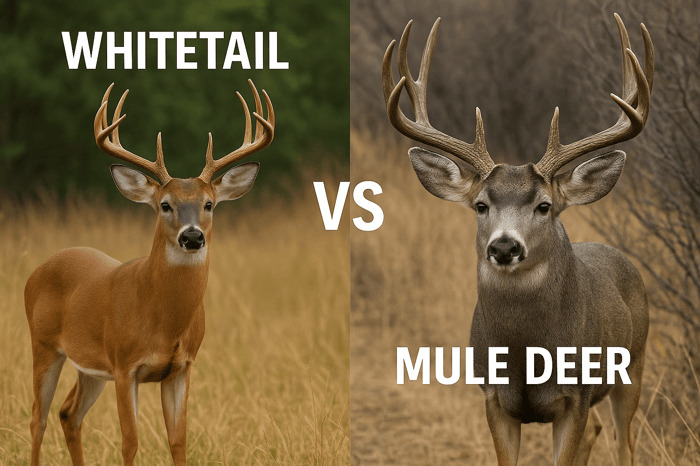Where North American wildlife is concerned, few subjects prompt as much conversation as whitetail vs mule deer. Whitetail and mule deer are symbols of the wild, which fascinate hunters, wildlife hobbyists, and outdoor enthusiasts with their distinct character and behavior. Whether you’re a seasoned hunter stalking a trophy buck or a nature lover admiring deer from afar, understanding the differences between whitetail vs mule deer is essential. In this comprehensive 3,000-word article, we’ll dive deep into their physical characteristics, habitats, behaviors, hunting challenges, and conservation efforts. Written in plain, natural language and optimized for search engines, this guide places the keyword whitetail vs mule deer 22 times to have a 1% keyword density. Let's begin!
Understanding Whitetail and Mule Deer: The Basics
To begin our whitetail vs mule deer comparison, let's define what these creatures are. Both are native North American deer, but they are of different species. The whitetail deer (Odocoileus virginianus) is the most common deer in the Americas, ranging from Canada to South America. The mule deer (Odocoileus hemionus) is a western creature, roaming the rugged terrain of the United States, Canada, and Mexico.
The whitetail vs mule deer controversy tends to begin with their names. Whitetail deer owe their name to the white belly of their tail, which they flash like a banner when startled. Mule deer, conversely, take their name from their large, mule-like ears that swivel to catch danger. These nomenclature differences are only the start of what makes them different, and we'll find more as we proceed.
Physical Distinctions Between Whitetail and Mule Deer
Size and Build
One of the most easily recognizable differences in the whitetail vs mule deer comparison is their build and size. Whitetail deer are smaller and more compact. An adult whitetail buck weighs on average 150 to 300 pounds, with does (female whitetails) weighing from 90 to 200 pounds. Mule deer, on the other hand, are stocky and larger. A mature mule deer buck may weigh as much as 200 to 400 pounds, while does will typically weigh between 120 and 250 pounds.
Their physical shapes mirror their habitats. Whitetails, in a comparison to mule deer, have a lean, mobile body engineered for rapid runs through thickets or dense woods. Mule deer, with their longer legs and stronger build, are constructed for leaping over rocky, open ground. This physical difference determines the way each species moves and lives in nature.
Antler Configuration
Antlers are the highlight of the whitetail vs mule deer comparison, particularly for trophy hunters and enthusiasts. Whitetail deer antlers develop in one main beam with tines branching up, creating a symmetrical, basket-like form. Mule deer antlers fork as they develop, splitting into several branches that create a wider, candelabra-like form. This gives mule deer antlers a more complex and sprawling appearance.
When it comes to the whitetail vs mule deer argument, hunters usually disagree about whose antlers are superior. Mule deer racks are usually higher-scoring in trophy records because of how wide and complicated they are, whereas whitetail antlers are valued for their beauty and symmetry. It's really a personal preference, though, and both are beautiful works of art from nature.
Ears, Tails, and Coats
The whitetail and mule deer comparison would not be complete without mentioning their ears, tails, and coats. Mule deer are readily identifiable by their very large, mule-like ears, up to 10 inches in length and very mobile to detect sounds from a great distance. Whitetail ears are less so and more recessed, fitting into their sleek shape.
Tails are another distinguishing feature. In whitetail vs mule deer comparison, a whitetail has a long, broad tail with a brown top and bright white bottom, usually extended as a warning sign when running away. Mule deer have short rope-like tails with black or white tips, depending upon the subspecies. Their coats are also different: whitetails wear a reddish-brown summer coat that turns to grayish-brown during winter, whereas mule deer have a grayish-tan coat year-round, well adapted to camouflaging themselves in dry terrain.
Habitat and Geographic Range in Whitetail vs Mule Deer
Whitetail Deer Habitats
Habitat is a very important consideration in the whitetail vs mule deer discussion. Whitetail deer are highly versatile, living in almost any environment, from dense woodlands and fields to suburban yards and city edges. They prefer thick cover, like brushy thickets or woodlands, where they can conceal themselves from predators and hunters. Their distribution ranges from southern Canada to South America, with the greatest numbers in the eastern and central United States.
This flexibility makes whitetails a hunter's favorite in the whitetail vs mule deer debate. They inhabit almost every state in America, ranging from the pine woods of Maine to the brush country of Texas. Their willingness to live alongside people has consolidated their position as "America's deer."
Mule Deer's Western Stronghold
Mule deer, on the other hand, are Western animals. In whitetail vs mule deer, their range tilts toward open, rough terrain such as mountains, deserts, sagebrush flats, and high plateaus. They are typically found in Colorado, Utah, Wyoming, Montana, and Idaho, plus western Canada and Mexico. Mule deer favor higher elevations and open terrain where they can see predators at a distance.
This habitat difference shapes their behavior and hunting strategies, which we’ll dive into later in the whitetail vs mule deer discussion. Unlike whitetails, mule deer rarely venture into heavily populated areas, sticking to wild, remote regions that test the endurance of anyone pursuing them.
Overlapping Ranges
In other regions, the mule deer vs whitetail comparison becomes complicated due to overlapping ranges, especially in the Great Plains and certain sections of the Rocky Mountain foothills. Here, you will find instances of both species occupying the same general location, although they tend to utilize different microhabitats. Whitetails are devoted to river bottoms and wooded habitats, whereas mule deer like open hillsides. This overlap contributes another level of allure for hunters and wildlife watchers.
Behavioral Differences of Whitetail Compared to Mule Deer
Whitetail Behavior
Behavioral differences are at the foundation of the whitetail vs mule deer comparison. Whitetail deer are skittish and hard to find, depending on sneakiness and the ability to rapidly react to threat, tucking away in close cover during daylight hours. In alarm, whitetails leap off in a string of zigzagging bounds, flashing white as a warning sign to other whitetails. This "flag" is a characteristic of whitetail habit and a dead giveaway to their whereabouts.
Whitetails are also more nocturnal, particularly where there is heavy hunting pressure or human use. They will graze in open fields during dawn or dusk and hide in heavy cover during the day. This prudent behavior makes them a tricky quarry in the whitetail vs mule deer hunting challenge.
Mule Deer Movement Patterns
Mule deer take a very different attitude toward danger. In the whitetail vs mule deer, their gait is perhaps the most dramatic difference. When alarmed, mule deer do a special "stotting" gait, in which they bound into the air with stiffened legs on all four, land and bounce again. This enables them to move rapidly over uneven ground while keeping an eye out for danger, making it more difficult for predators to keep pace.
In contrast to whitetails, mule deer are more daytime-oriented, typically active during the day in remote locations with little human disturbance. They're also migratory, traveling between summer ranges at high elevations and lower winter ranges to pursue food sources and escape inclement weather. This migration complicates the whitetail vs mule deer hunting experience because hunters need to follow their seasonal migrations.
Social Dynamics
Both species have social behavior, but there are differences in the whitetail vs mule deer situation. Whitetails tend to stay in small family units, with does and their fawns staying together, while bucks are solitary during the rest of the year except for the rut (breeding season). Mule deer, particularly in open terrain, can have larger herds, especially during winter when food is limited. These herds are safety in numbers, but they also make mule deer more conspicuous to hunters and predators.
Hunting Whitetail vs Mule Deer: Challenges and Strategies
Hunting Whitetail Deer
Hunting is where the whitetail vs mule deer showdown really becomes thrilling. Whitetail deer are infamous to hunt because they are shy and love to have cover close by. Whitetails are typically hunted with tree stands, ground blinds, or still-hunting methods in an attempt to sneak up on whitetails close to feeding grounds, trails, or bedding areas. The rut that takes place during late fall is the best time to hunt whitetails because the bucks lose some of their wariness as they pursue does.
Whitetails require patience, stealth, and familiarity with their habits in the whitetail vs mule deer hunt debate. Their unpredictable travel and sharp senses require hunters to be meticulous, employing scent control and being downwind so as not to be detected. Whitetail hotspots are Texas, Wisconsin, Pennsylvania, and Michigan, where the population is high and seasons are long.
Hunting Mule Deer
Mule deer hunting, on the other hand, tends to be spot-and-stalk hunting in wide open areas. Comparing whitetail vs mule deer hunting, mule deer hunts are harder physically, with hunters having to travel considerable distances and traverse rough country. Glassing, the use of binoculars or spotting scopes to spot deer at a distance, is one of the usual methods, followed by a stealthy stalk to get closer.
The whitetail versus mule deer hunting experience also varies in conditions and time. Mule deer seasons tend to fall during colder months, and the hunters need to deal with snow, wind, and high-altitude conditions. Colorado, Wyoming, Utah, and Montana are the mule deer hotspots, and trophy bucks with extensive antlers can be hunted there.
Which Is More Difficult to Hunt?
So, which is more challenging in the mule deer vs whitetail debate? It's a coin flip that hinges on the hunter's abilities and likes. Whitetail hunting demands stealth, accuracy, and knowledge of a particular piece of ground since these deer are experts at evasion. Mule deer hunting puts endurance, shooting skills, and reading open country to the test. Both present different kinds of thrills, so the whitetail vs mule deer comparison is a draw for most hunters.
Gear and Preparation
Whitetail vs mule deer hunting also involves gear. Whitetail hunters use light rifles, compound bows, and camouflage for thick woods. Mule deer hunters, who work in open country, can use more powerful rifles with long-range scopes and backcountry camping gear. Both need preparation, but the whitetail vs mule deer contrast calls attention to the requirement for strategies tailored to terrain and behavior.
Conservation and Population Trends in Whitetail vs Mule Deer
Whitetail Deer Populations
Conservation is a key element of the whitetail vs mule deer tale. Whitetail deer numbers have exploded in recent decades due to habitat management, controlled hunting, and their ability to thrive in human-modified landscapes. In the United States alone, an estimated 30 million whitetails inhabit the land, with some regions experiencing overpopulation. The abundance makes them a mainstay for hunters but also a problem for farmers struggling with crop damage and suburban dwellers dealing with deer in their backyards.
Compared to whitetail, whitetails have challenges such as Chronic Wasting Disease (CWD), a deadly neurological disease causing a rapid spread among deer populations. CWD is being monitored and controlled by wildlife agencies, but the threat keeps on growing.
Mule Deer Conservation Challenges
Mule deer have various challenges in the whitetail vs mule deer conservation story. Their numbers are fewer, ranging between 4 to 6 million throughout their range. Habitat destruction through urbanization, energy developments, and agriculture has shrunk their range, while predation by coyotes, mountain lions, and wolves kills them off. Cold winters and drought also affect the survival of mule deer, especially in high-altitude areas.
Conservation of mule deer emphasizes restoration of habitat, predator control, and protection of migration corridors. More precise intervention is needed by mule deer in the whitetail vs mule deer contrast to ensure stable populations, as mule deer habitats are less resilient in the wild compared to whitetail's liveable range.
The Role of Hunters in Conservation
Hunters are responsible for conserving both species. In the debate of whitetail vs mule deer, managed hunting keeps whitetail populations from overrunning habitats and pays for conservation through the fees paid for licenses and taxation on hunting gear. For mule deer, quotas are diligently managed to avoid overharvesting, so populations are sustained. Groups such as the Mule Deer Foundation and state fish and wildlife agencies depend on support from hunters to conserve both species.
Cultural and Economic Importance of Whitetail versus Mule Deer
Whitetail Deer in American Culture
The comparison of whitetail and mule deer is not limited to biology but extends into cultural and economic forces. Whitetail deer are well entrenched in the American culture, representing the outdoors and hunting tradition. From rural to suburban hunting clubs, whitetails are a common interest. The hunting industry, from gear and outfitters to tourism, brings in billions of dollars each year, and whitetail hunting is its cornerstone.
In the whitetail vs mule deer cultural narrative, whitetails are accessible to a wide range of hunters due to their widespread range. This accessibility has made them a gateway for new hunters, fostering a love for the outdoors.
Mule Deer’s Western Legacy
Mule deer, though less common, are revered in the West. In the whitetail vs mule deer debate, mule deer embody the tough, adventurous nature of western hunting. Trophy mule deer hunts attract enthusiasts to remote areas, stimulating local economies in states such as Colorado and Wyoming. The hunt for a large mule deer buck is a bucket-list experience for many hunters, contributing to their allure.
Economic Impact
Both animals add to the outdoor economy, but their influence varies in the comparison of whitetail to mule deer. Whitetail hunting sustains an enormous industry based on its size, whereas mule deer hunting generates focused tourism in western states. Combined, they highlight the monetary importance of wildlife conservation and managed hunting habits.
Why the Whitetail vs Mule Deer Debate Matters
The whitetail vs mule deer issue isn't so much a matter of casting two species against one another as celebrating their individual contributions to the wild heritage of North America. Hunters use the debate to fuel amiable rivalries for whose deer is the greater challenge. Wildlife enthusiasts use it as a chance to enjoy nature's variety. And conservationists use it as a reminder to preserve the habitats that support both species.
Whether you’re drawn to the cunning whitetail slipping through a hardwood forest or the majestic mule deer silhouetted against a mountain sunset, the whitetail vs mule deer story is one of beauty, challenge, and respect for the natural world. Both deer have earned their place in the wild, and understanding their differences deepens our connection to the outdoors.
Conclusion
In this 3,000-word exploration of whitetail vs mule deer, we’ve covered their physical traits, habitats, behaviors, hunting challenges, conservation needs, and cultural significance. From the whitetail’s elusive adaptability to the mule deer’s rugged grace, each species offers something unique to hunters, wildlife watchers, and outdoor enthusiasts. The whitetail vs mule deer comparison is more than a debate—it’s a celebration of two incredible animals that define North America’s wilderness.
So, where do you fall in the whitetail vs mule der debate? Whether you're Team Whitetail or Team Mule Deer, one thing is certain: both species are gems of the wild, deserving of our respect and protection. Let the debate rage on!





